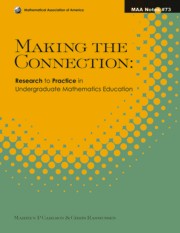Book contents
- Frontmatter
- Preface
- Contents
- Part 1 Student Thinking
- Part 2 Cross-Cutting Themes
- 2a Interacting with Students
- 13 Meeting New Teaching Challenges: Teaching Strategies that Mediate Between All Lecture and All Student Discovery
- 14 Examining Interaction Patterns in College-Level Mathematics Classes: A Case Study
- 15 Mathematics as a Constructive Activity: Exploiting Dimensions of Possible Variation
- 16 Supporting High Achievement in Introductory Mathematics Courses: What We Have Learned from 30 Years of the Emerging Scholars Program
- 2b Using Definitions, Examples and Technology
- 17 The Role of Mathematical Definitions in Mathematics and in Undergraduate Mathematics Courses
- 18 Computer-Based Technologies and Plausible Reasoning
- 19 Worked Examples and Concept Example Usage in Understanding Mathematical Concepts and Proofs
- 2c Knowledge, Assumptions, and Problem Solving Behaviors for Teaching
- 20 From Concept Images to Pedagogic Structure for a Mathematical Topic
- 21 Promoting Effective Mathematical Practices in Students: Insights from Problem Solving Research
- 22 When Students Don't Apply the Knowledge You Think They Have, Rethink Your Assumptions about Transfer
- 23 How Do Mathematicians Learn To Teach? Implications from Research on Teachers and Teaching for Graduate Student Professional Development
- About the Editors
14 - Examining Interaction Patterns in College-Level Mathematics Classes: A Case Study
from Part 2 - Cross-Cutting Themes
- Frontmatter
- Preface
- Contents
- Part 1 Student Thinking
- Part 2 Cross-Cutting Themes
- 2a Interacting with Students
- 13 Meeting New Teaching Challenges: Teaching Strategies that Mediate Between All Lecture and All Student Discovery
- 14 Examining Interaction Patterns in College-Level Mathematics Classes: A Case Study
- 15 Mathematics as a Constructive Activity: Exploiting Dimensions of Possible Variation
- 16 Supporting High Achievement in Introductory Mathematics Courses: What We Have Learned from 30 Years of the Emerging Scholars Program
- 2b Using Definitions, Examples and Technology
- 17 The Role of Mathematical Definitions in Mathematics and in Undergraduate Mathematics Courses
- 18 Computer-Based Technologies and Plausible Reasoning
- 19 Worked Examples and Concept Example Usage in Understanding Mathematical Concepts and Proofs
- 2c Knowledge, Assumptions, and Problem Solving Behaviors for Teaching
- 20 From Concept Images to Pedagogic Structure for a Mathematical Topic
- 21 Promoting Effective Mathematical Practices in Students: Insights from Problem Solving Research
- 22 When Students Don't Apply the Knowledge You Think They Have, Rethink Your Assumptions about Transfer
- 23 How Do Mathematicians Learn To Teach? Implications from Research on Teachers and Teaching for Graduate Student Professional Development
- About the Editors
Summary
While discussing the pedagogical challenges of teaching an undergraduate discrete math course, one of our colleagues recently lamented that
Students are ill-prepared for this course…but this ill-preparation is a curious issue. I think it has more to do with the way they learned mathematics than with the content of the previous courses.
In this chapter, we propose a response to his comment. In particular, the goal of our discussion is to illustrate that the ways in which teachers and students interact can profoundly affect the attitudes students form as well as the content they learn.
Why Study Interaction Patterns?
This view of the importance of interaction styles is consistent with a conclusion reached by Stigler and Hiebert (2004) regarding their recent international study of teaching patterns across the world:
A focus on teaching must avoid the temptation to consider only the superficial aspects of teaching: the organization, tools, curriculum, content, and textbooks. The cultural activity of teaching – the ways in which the teacher and students interact about the subject – can be more powerful than the curriculum materials that teachers use. … We must find a way to change not just individual teachers, but the culture of teaching itself. (p. 16)
In short, not just what we teach, but how we teach and communicate with students – what we call interaction patterns – appears to have great influence on student learning. In this chapter, we describe several interaction patterns that educational researchers have identified.
- Type
- Chapter
- Information
- Making the ConnectionResearch and Teaching in Undergraduate Mathematics Education, pp. 179 - 190Publisher: Mathematical Association of AmericaPrint publication year: 2008
- 1
- Cited by



